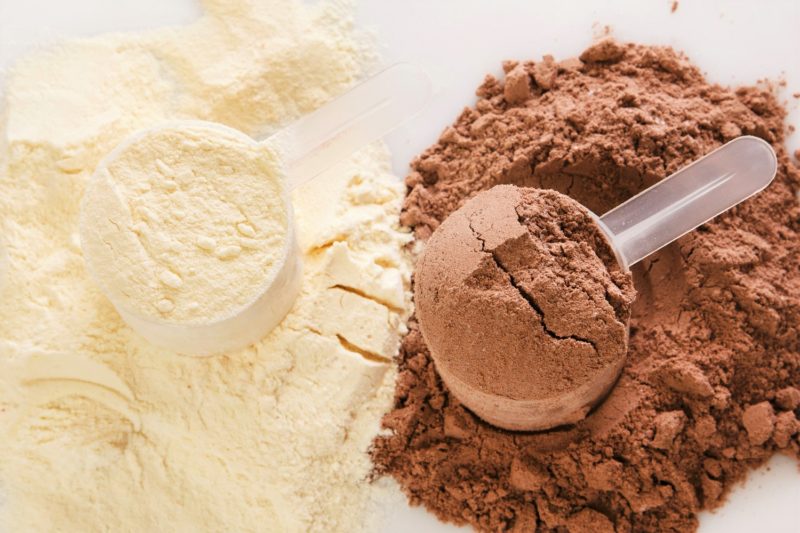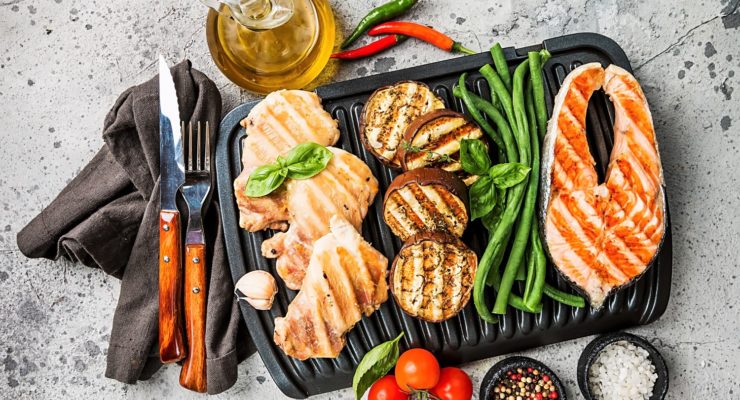Your Foolproof Guide to Protein Powder
Article posted in: Diet & Nutrition
Protein really does amazing things: It builds muscle, which, besides looking good and being useful for carrying heavy things, burns more calories at rest than fat. Eating protein can also help you eat fewer calories that you have to burn in the first place—it takes longer to digest than carbohydrates, meaning you feel fuller, longer. No wonder foods like peanut butter, snack bars and even cereal are touting how protein-rich they are on their boxes—even if the protein is dwarfed by carbs or fat. And if you click on any fitness or weight loss website, you’ll not only hear the praises of protein sung, but that one of the singers in your personal choir should be protein powder.
But you’ve probably got questions: Do I really need protein powder? Where does it come from? What are the different types? Here’s your ultimate guide to protein powder, answering all the questions you’re probably asking—and some you may not have even thought of:
1. How much protein do I really need in my diet?
The short answer is that it depends on your diet plan. In a “40-30-30” diet, dieters eat 30 percent of their calories from protein (another 30 from fat, and 40 from carbs). So if you’re eating a 1,500 calorie diet, that would be 450 calories per day from protein sources, or 113 grams—roughly the amount you’d get from eating about four chicken breasts during the day. And if eating four chicken breasts sounds like “I might turn into a chicken,” than a shake might be somewhere you’d turn. (Note: Those on the Nutrisystem program are eating between 45 to 55 percent of calories from carbohydrates, 25 to 30 percent from protein, and less than 30 percent from fat).
Bodybuilders have long sworn by a ratio of one gram of protein for every pound of body weight. But they don’t need that much: In a study from 1988, bodybuilders who were losing weight were able to maintain muscle mass while eating just 0.73 grams of protein per pound of body weight. And in a study from 2008, gym-goers were able to maintain lean body mass by eating just 0.82 grams per pound of body weight even while they were creating an energy deficit of 1,000 calories per day. But that’s still a lot: For a 200-pound man, that’s 127 grams of protein.
But if you’re not on a 40-30-30 diet or not a budding Mr. Olympia, you don’t need all this protein in your diet to lose weight. You need a caloric deficit, which any good weight loss plan will provide. The daily recommended amount of protein is around 56 grams for men, and 46 grams for women. Those more reasonable numbers can easily be reached with just food.
2. So should I be supplementing my protein intake?
From the standpoint of dietary NEEDS, probably not. But multiple studies have shown that eating more protein than the recommended amount doesn’t have deleterious health effects, and it can help manage hunger to aid in weight loss: Protein takes longer to digest than carbohydrates, meaning you’ll stay full for longer. And it can reduce cravings. A study from the University of Missouri used MRI scans and, in those who consumed more protein, found significantly reduced activity in the parts of the brain associated with cravings. Researchers believe that this is because people who eat protein-rich foods produce less of a hunger-stimulating hormone called ghrelin.
Protein powder can also help with a specific craving for sweetness. Nutrisystem dietitians say that when a craving hits, the best way to tackle it can be head on—eating a small, measured portion of the food or flavor you’re craving instead of grazing endlessly on unsatisfying alternatives. If you love chocolate, or just sweet stuff, a protein shake is a fantastic alternative that also scratches the itch: While a candy bar might be 250 quick-burning carb calories, a scoop of chocolate-flavored protein powder (like the popular Nutrisystem Protein Shakes) can be fewer than 150 calories, and delivers those extra grams of filling protein.
3. OK, besides craving time, when should I use protein powder?
If you’re supplementing to try to build muscle, the recommended timing for a shake is usually right after your workout—and in those cases, the protein recommended is usually whey. In a recent study from Nutrition and Metabolism, whey supplements were found to create a greater change in the arm circumference of weight lifters than pea protein, a vegetarian option that is often considered “complete” (though it should be noted that pea protein users increased muscle “thickness” more than whey users in the study).
But if you’re not hoping for huge muscle gains, breakfast can be a great time for protein supplementation. While the American diet has usually emphasized carbs in the morning (cereal) and protein at night (steak), front-loading the day with protein has been shown to have a good effect on weight loss: A study of police officers published in Obesity in 2011 found that cops who ate a carb-focused dinner and a less carb-centric meal earlier in the day lost more than 25 percent more fat than those on a “normal” diet with more carbs earlier in the day. Those eating protein earlier in the day had a positive effect on their body’s levels of a hunger-suppressing hormone called leptin. In another study from 2013, scientists found that people who ate 35 or more grams of protein at breakfast ate fewer high-sugar, high-fat snacks in the evening compared to people who either skipped breakfast or ate cereal.
One easy way to incorporate protein powder in the a.m. is in your coffee: A scoop of Chocolate Nutrisystem Protein Shake Mix can turn a tall mug of black coffee into a sweet treat that’s worthy of $5 and a wait in a fancy coffee shop line. But while a medium café mocha is almost 300 calories, this alternative comes in at just 120 calories. Paired with an egg and some veggies or a piece of fruit, it’s a phenomenal way to start the day.
If powder in the morning isn’t your thing, the right time for a shake may be whenever you’re hungry: A high-protein snack can help you get and stay full until it’s mealtime again. If you decide to take a shake as your snack, consider holding off until after lunch: Research from the Journal of the American Dietetic Association showed that dieters who snacked in mid-morning tended to eat more throughout the day than those who had a snack in the afternoon.
4. Does it matter what my protein powder is made of?
If you care about building muscle, yes: The study mentioned above, published in Nutrition and Metabolism, states that the concentration of leucine, an amino acid, in protein is the “strongest determinant of the capacity of a protein” to affect muscular growth. In the study, whey proteins were found to have as much as two times the leucine found in soy, pea and rice proteins.
For non-bodybuilders, protein type matters, too: Protein “concentrate” is a powder that could be about 70 percent protein, with the rest consisting of a balance between carbs and fat. This is the category in which Nutrisystem shakes fall. On the other hand, protein “isolate” is a more concentrated source of protein, resulting in a powder that’s as much as 95 percent protein.
Certain proteins are also what’s known as “incomplete”: That means that they contain some, but not all, of the nine amino acids that can’t be produced by the body. In order to get these amino acids, you’ve got to eat them—and in order for protein to act in muscle synthesis, you need all nine. That’s why when forming a meatless Monday meal, it’s often recommended that you combine rice and beans: Not only are they delicious together, but collectively, they contain all nine essential amino acids. Alone, neither food has them all.
Rice protein powder, then, is an “incomplete” protein. While it’s become a popular alternative for vegetarians, the powder must be fortified to become a complete protein and help in muscle building; this powder may come with fiber, though.
Soy protein powder is “complete,” but it has a lower “protein efficiency ratio,” a measure of the amount that becomes available for the body to use, than other protein sources. A review in the Journal of Sports Science and Medicine suggests that of the soy protein you consume, only about 60 percent is usable. Look for powders that contain greater than 20 percent of your daily recommended amount of protein.
The most common protein powder options come from milk, in the form of whey and casein protein. Both of these are made by separating milk fat and sugars from its protein, and both are highly digestible: With whey, 92 percent of the protein you ingest is usable by the body. For casein, it’s only 76 percent—but casein is often used because it releases more slowly than whey powder. While whey is often consumed and absorbed right after a workout, many exercisers have more expensive casein protein right before bed, allowing it to release while they sleep.
But both whey and casein concentrates can cause stomach problems: If you have trouble digesting milk, the leftover milk sugars could potentially be a problem, so be careful. Egg protein powder is available to those with trouble digesting whey or casein, and is the most bio-available protein you can drink, with 94 percent of the protein being usable by the body. But egg protein powder is expensive—more so than just eating eggs, usually.
Pea protein is vegetarian option that many consider complete, and may be a good alternative for those who can’t digest whey or casein. It’s bio-available at a rate in the 75 percent range, according to a study in The Journal of Nutrition. That’s right around casein—but usually requires some supplementation to be a complete protein, as no vegetable alone provides all nine amino acids. (Find out some of the best plant-based sources of protein.)









